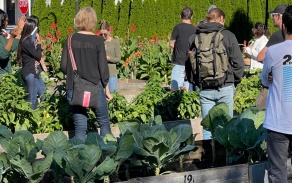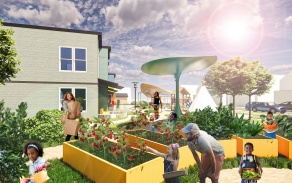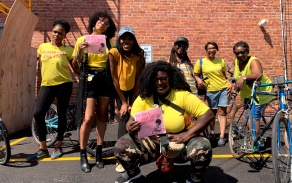Rebuilding Buffalo on active hope
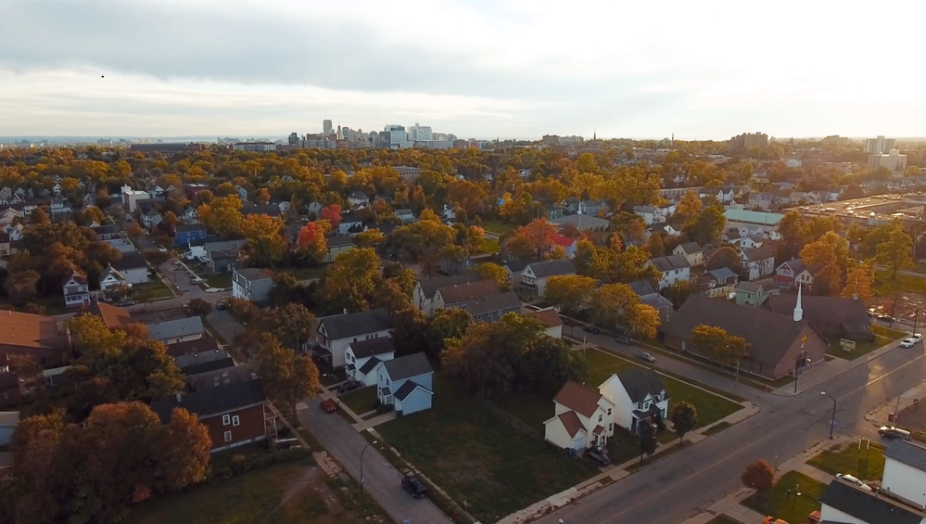
View of Buffalo's East Side and into downtown, courtesy of East Side Avenues/UB Regional Institute
Buffalo and its East Side are ground zero for more just ways of living, and a lever of change for cities
by Robert G. Shibley, FAIA, FAICP
SUNY Distinguished Professor, School of Architecture and Planning
Since our founding 50 years ago, the University at Buffalo’s School of Architecture and Planning has created the conditions for hope through acts of citizen-driven planning, design and building across the city that hosts us. In grounding our teaching and research in the aspirations of our community and a shared affection for place, we rebuild our city, improve life for its citizens, and drive innovations in design and planning that scale up to cities around the world and into the professions we serve.
On May 14, 2022, a horrific act of racist hate sent shockwaves through our city, and we were reminded just how far we have to go – as a society, as a city, and as a profession.
The mass shooting at a grocery store in East Buffalo was the collision of an acute act of violence with an equally insidious legacy system of segregation in our cities that isolates, neglects and harms segments of the population along the lines of race. East Buffalo, where 80 percent of Buffalo’s Black population resides, has suffered decades of disinvestment. The systems of inequity are so deeply embedded that over the past three decades the city’s Black community has seen little progress (and in some cases none at all) on key indicators of quality of life – from income and educational attainment to homeownership and health outcomes.
As a community of educators, scholars and practitioners in the built environment professions, we grieve the loss of life, the trauma inflicted upon our city, and the shortcomings of society in addressing the entrenched injustices of racism. May 14 calls attention – yet again – to the challenge of our time – rebuilding our cities as places where all have the opportunity for life lived well.
The imperative and opportunity before us is to dig in, bringing our whole selves to action on behalf of justice in our city. Buffalo and its East Side is ground zero for more just ways of living, and a lever of change for all cities. Drawing upon the guidance of climate activist Joanna Macy and psychologist Chris Johnstone, it is here where we come with gratitude to teach and practice “active hope” with the people of Buffalo – project by project, increment by increment, year over year.
Today, this active hope continues to lift up a new wave of design and planning innovations across the urban landscapes of Buffalo’s East Side, focused squarely on the needs and aspirations of our most vulnerable citizens. The process of learning with our community turns ideas into action while building capacity among citizens and our students – future architects, planners and developers – for the long-term work of equitable placemaking.
As the State University of New York’s only accredited graduate school of architecture and planning, situated in the premier public research university of the Northeast, we are uniquely positioned to move the needle on equity in the built environment for Buffalo. While we acknowledge we have miles to go, we stand up with the collaborative work in our communities in recognition that hope is not given, it is created.
The call to action – for Buffalo, for cities like it, and for those who teach and practice our professions – is to root ourselves ever deeper in place and community and build the path to healing through active hope.
- Robert G. Shibley, Dean and SUNY Distinguished Professor, School of Architecture and Planning, University at Buffalo

This article was originally published in the June/July 2022 issue of ARCHITECTURE New York State, the quarterly magazine of AIA New York State. View the article here
The 2021 cohort of East Side Avenues’ Community-Based Real Estate Training program. Photo courtesy of UB Reginal Institute
East Side Avenues, led by our UB Regional Institute, has engaged hundreds of citizens and businesses, as well as an unprecedented coalition of Buffalo-based banks and foundations, to provide capacity-building and infrastructure supports that reinforce more than $200 million in New York State capital funds flowing into the East Side. Its Community-Based Real Estate Development Training program keeps those investments in the community by educating residents and building owners in commercial real estate development. Tapping the expertise of our master’s program in real estate development, the training initiative has graduated more than 30 students in its first two years with continued mentorship to support their development ideas.
Students in a graduate architecture studio visit Buffalo Go Green on the East Side for a design-build project that will help the nonprofit expand its urban farm operation. Photo courtesy of Buffalo Go Green
Buffalo Go Green (BGG) is part of an emerging coalition of Black-led community organizations addressing conditions of food apartheid on Buffalo's East Side. It's also part of a national grant to UB's Food Systems Planning and Healthy Communities Lab to bring the practices of Buffalo's urban farmers of color to communities around the world. That same grant is supporting a graduate architecture studio’s design-build of a 150-foot fence that will enclose five vacant lots for BGG’s new greenhouses and engage the community with features for public art, planting and seating.
UB Master of Architecture student Chenhui Yang’s proposal for “Bailey Commons” on the East Side integrates daycare, affordable live-work apartments, a playground and community gardens. It’s part of a series of proposals co-designed with the community now moving into the first phase of construction.
Just down the street from BGG’s headquarters, an architecture and urban design studio is working with neighborhood residents to transform a series of vacant lots into a mix of green space, housing and community services. The project builds off a decade-long master planning initiative for the neighborhood engaging multiple studios at the School of Architecture and Planning and the support of a local business hoping to improve the surrounding community.
Citizen activist and Master of Urban Planning student Jalonda Hill (third from right) with members of Colored Girls Bike Too. She enrolled in our Citizen Planning School to advance a project that rebuilds the East Side through mobility justice. Photo by Abby Wojcik, Rise Collaborative
For the past decade, our award-winning Citizen Planning School has mobilized dozens of citizen activists across Buffalo with the tools of urban planning and design. Among its most recent graduates is former East Side resident and UB Master of Urban Planning student Jalonda Hill, founder of Colored Girls Bike Too (CGBT). She enrolled in the Citizen Planning School to help design her new project, the Holistic Mobility Hub, part of CGBT’s new Black Holistic Urbanism initiative focused on mobility justice. Hill is now prepared to launch a capital campaign for the mobility hub, which will include a bike shop, mobility bank, travel hub and just streets infrastructure design.
A formal connection between the Center for Urban Studies and the Community Health Equity Research Institute at UB is sharpening the focus on Buffalo’s built environment and its impact on the city’s social determinants of health.
Meanwhile, the recent alignment of our Center for Urban Studies, a neighborhood planning group focused on the needs of traditionally marginalized groups, with UB’s Community Health Equity Research Institute, joins urban planners with UB medical students and scholars to address race-based health disparities on the East Side and across Buffalo. “Making the Center for Urban Studies part of the Community Health Equity Research Institute represents a wonderful opportunity to marry our work on underdeveloped neighborhoods and issues with the built environment directly with the health disciplines on campus,” says Henry-Louis Taylor Jr., UB professor of urban and regional planning and founder of the Center for Urban Studies.
A new Sustainability Workforce Training Center designed by UB architecture students for PUSH Buffalo will house a green workforce training program to recruit participants from among the area’s unemployed and underemployed populations.
The movement toward justice on the East Side is reinforced by a critical mass of community-based research across our city, including an initiative to train Buffalo’s workforce in climate-resilient design and development. The partnership with with People United for Sustainable Housing (PUSH Buffalo) is supporting the design of PUSH Buffalo’s new Sustainability Workforce Training Center, a 2,500-square-foot, zero-net energy building that will house a six-week training program to prepare unemployed and underemployed individuals for the local green workforce. The project leverages PUSH Buffalo’s efforts to expand local hiring opportunities and advance economic and climate justice with faculty expertise adapting the built environment to extreme weather and climate change.

UB alumnus Gail V. Wells speaks to volunteers from the community, including UB Food Lab team members, who had gathered to distribute raised bed gardens to Buffalo residents through Buffalo Freedom Gardens. Photo: Douglas Levere
UB alumna's "Freedom Gardens" fights racism with food
UB MUP alumnus Gail V. Wells is placing food at the center of a movement toward justice and freedom for the people of Buffalo. Since its founding in 2020, her Freedom Gardens project has installed 134 raised beds in communities of color in Buffalo. The group’s mission — fighting racism, inspiring resilience and providing fresh vegetables in neighborhoods that lack grocery stores and access to healthy foods — is resonating, once again, in the wake of the racist mass shooting on May 14 at the Tops supermarket on Jefferson Avenue. In the weeks since then, Freedom Gardens has been among community groups in Buffalo that have joined together to call for an end to acute and chronic violence against Black people, and to take action on food equity. Learn more about how to support the Freedom Gardens initiative

The School of Architecture and Planning recently installed “The City and Its School,” a presentation of our two internationally-debuted exhibitions exploring the School’s 50-year investment in its host city. On view from April 6 - May 19, 2022, at the CEPA Gallery in downtown Buffalo, “The City and Its School” ran in line with the School's 50+ Anniversary Celebration. Photo by Douglas Levere
Our work with the citizens of Buffalo over the past 50 years has laid the foundation for Buffalo's post-industrial transformation while generating an innovative experiential education model that both draws upon and feeds back into the knowledge base of our surrounding community.
The reciprocal relationship between the School and Buffalo has gained international recognition in recent years. In 2018 and 2021, the School was invited to share its “city-as-lab” model of teaching and research at the international Time Space Existence exhibition, which takes place in the context of the Venice Architecture Biennale – the preeminent global forum for architecture and design.
"See It Through Buffalo"
The team behind "See It Through Buffalo" shares the vision for our documentary short on the City of Buffalo.
“See It Through Buffalo” is a documentary short and cinematic tribute to the varied urban landscapes of Buffalo, where faculty and students work hand-in-hand with the community to address issues such as energy-efficient design, economic development, food systems planning, and refugee resettlement. It was co-produced with noted Buffalo filmmaker John Paget of First+Main Films, and directed by Gregory Delaney, UB clinical assistant professor of architecture. Since its debut in Venice at the 2018 Time Space Existence exhibition, “See It Through Buffalo” has been screened at the Ford Foundation Center for Social Justice in New York City in 2019 and was an official selection of the United Nations-Habitat “Better Cities Film Festival” in Abu Dhabi in 2020. We invite you to enjoy the full film as shown in Venice, Italy, and to learn more about the making of the film and its representation of our work within Buffalo over the past five decades.
"Buffalo Constructing Buffalo: From Olmsted to Van Valkenburgh"
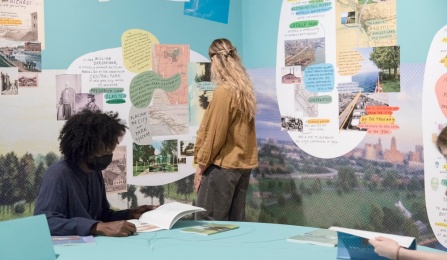
"Buffalo Constructing Buffalo: From Olmsted to Van Valkenburgh," installed at the 2021 Time Space Existence exhibition in Venice's historic Palazzo Mora. Photo by gerda studio.
“Buffalo Constructing Buffalo: From Olmsted to Van Valkenburgh,” which debuted at the 2021 TIme Space Existence exhibiton in Venice, Italy, showcases the School’s engagement of more than 2,000 citizen voices in the planning of Buffalo’s Ralph C. Wilson, Jr., Centennial Park, emerging today on the city's Lake Erie shoreline. Presented as a visual narrative, “Buffalo Constructing Buffalo” tells a multi-layered story about the complex relationship between a school and its city, capturing the collective impact of hundreds of acts of planning, design and making in the city and region led by faculty, students and the citizens of Buffalo over the past half century. Curated by Dean Robert G. Shibley, the exhibition is presented as a series of illustrated story boards created by Buffalo-based visual artist Ariel Aberg-Riger, with exhibition design led by former UB architecture professor Julia Jamrozik.
Founded in 1969 as the “School of Architecture and Environmental Design,” we began as a self-described “band of renegades” leading a radical experiment in design education, one that situated the study of design and planning in its social contexts. Today, we hold the top ranks in research among architecture and planning schools across the nation; are known world-wide for our “city-as-classroom” approach to teaching and research; and extend our reach around the world through global scholarship and a network of nearly 6,500 alumni.


